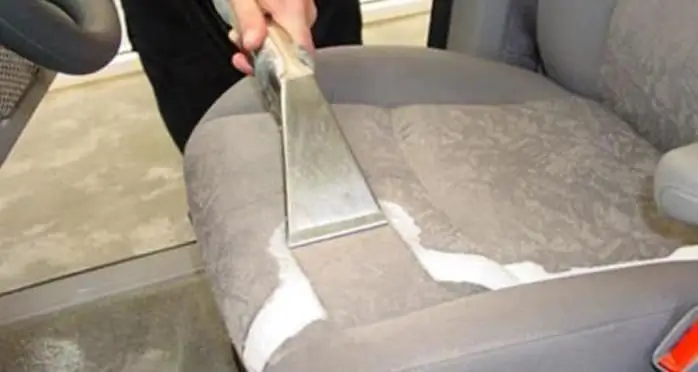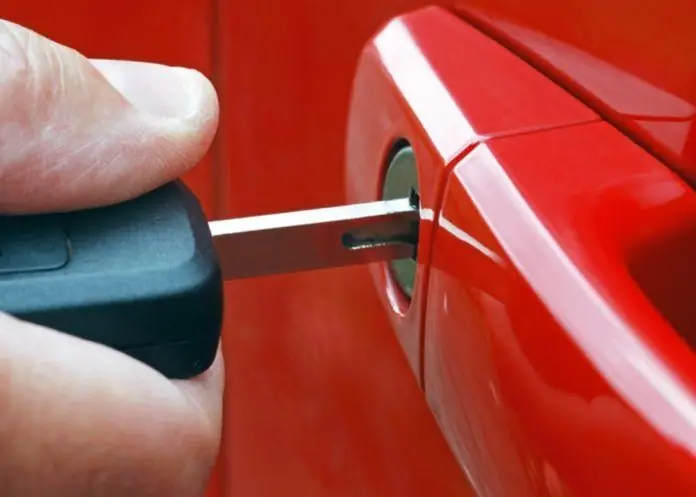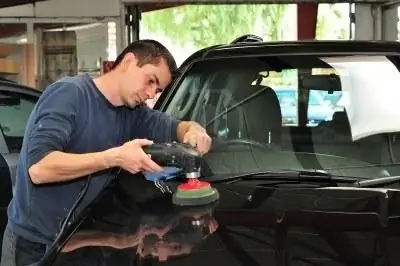2026 Author: Erin Ralphs | [email protected]. Last modified: 2025-01-22 21:14:09
During operation, the car's paintwork deteriorates. There are quite a few reasons for this - both external factors (rain, snow, frost and dirt) and mechanical damage (scratches, chips, abrasions). It is completely impossible to avoid the deterioration of the varnish and paint. But you can polish the body, which will help make the color like a new car. Many people think that the polishing process is extremely complicated, and it is necessary to give the car to specialists, but this is not at all the case.

General polishing information
Polishing is the removal of cracks, scratches, uneven coloring and other defects in the paintwork. The term itself means "to make smooth". Actually, from matte paint, which has become such over the years of operation, it can easily be made glossy. For example, if you are going to sell your car, it is recommended to polish it before selling it. This will significantly increase the cost of the car. After all, the opinion of the buyer is formed by appearance. Therefore, if high-quality body polishing is done, then most likely it will be possible to get a better offer.
Yes, and in general appearance determines a lot. But it's not just beauty. Another task of polishing is to protect the paintwork from the effects of aggressive substances on the car body. Moisture and s alts penetrate deep into the paint through microcracks and reach the metal, after which the corrosion process starts, gradually destroying both the paint and the car as a whole.
Main types of polishing
Before proceeding directly to the work, you need to understand a little about the types of polishing. Currently, they are usually divided into two large groups:
- Protective polishing - applying wax, ceramic or synthetic compounds to the paintwork that protect the car body from ultraviolet radiation, etc. Great option for a freshly painted car with good paintwork.
- Abrasive polishing - grinding the surface with a paste, which contains abrasive particles. The method allows you to remove scratches, chips and other defects from the surface of the varnish. The abrasive can be fine, medium or coarse. The worse the condition of the body, the greater the fraction of abrasive particles. After that, it is desirable to carry out protective polishing, which will make it possible to secure the paintwork for a long time.

When should you consider polishing?
Regardless of car class andthe age of the paintwork, it is necessary to carry out protective polishing of the car body. As for abrasive processing, the first step is to assess the current state. If the paintwork has the following defects, then it is necessary to perform polishing:
- Paint fading from exposure to ultraviolet light. LPC loses saturation and has a different shade, as it burns out unevenly.
- Coat defects from tar, winter chemicals, s alt, or even bird droppings.
- Mechanical damage to the paint due to sand getting on the body, abrasions from branches and much more.
Depending on the number of different defects and the severity of the verdict. If the appearance of the car after washing has not improved, then it is worth considering. Well, what does the body polishing process look like, we will consider in this article.

Important in brief
There are some simple rules for beginners. First, do not be afraid to polish the car body. If you use the right materials, nothing bad will happen. Secondly, it will not be possible to complete the work using the machine. There are many areas on the car that require manual polishing. It takes significantly more time, but it's worth it.
It is advisable to use high-quality materials and polishes. This will give you good results. It is recommended to use various kinds of sponges and abrasive wheels, which are attached to the grinder by means of a substrate. You can alsoapply and sandpaper of the required grit. The protective layer is best applied by hand.
Protective polishing of car body
As for this type of coverage, there are a number of specific nuances. The main one is the selection of materials depending on the season. The fact is that wax-based pastes are not recommended for use in the winter. This is due to the fact that they will not give shine, but rather the opposite. But in summer, wax gives just a great shine and makes the car look chic.

Another important point when performing protective polishing of the body is the absence of dust in the room. It hardly needs to be said once again that the car must be clean and dry, as well as fat-free. Performing work with a machine, you can easily leave traces of coarse dust. Therefore, fiber should be considered more preferable. You should constantly monitor the process. At the end of the work, it is desirable to allow the polish to soak in and dry well. The recommended time is indicated in the instructions for the paste.
Materials needed to complete the work
The initial set largely depends on what kind of polishing will be done. If we are talking about protective, which is much simpler in its technology, then you need to get the following: a good car shampoo, solvent (anti-silicone), microfiber, polishing agent (paste or liquid), masking tape to protect plastic and rubber moldings from chemicals. You can also use a grinder if you have access to it.

As for the abrasive polishing of the body, then the set of tools is much larger. You need to bring detergent and water spray with you, you can not do without polishing paste and sandpaper. It is advisable to have a set of abrasive wheels of various grain sizes with you. The kit also includes such tools and mechanisms as anti-silicone, anti-tar, microfiber and a grinder. Well, then you can proceed directly to the work.
Do-it-yourself car body polishing: the main steps
The first step is to thoroughly wash and dry the car. Then it is treated with a degreaser. At the same time, it is worth paying attention to the fact that there are no stubborn stains of dirt from resin or insects on the body. For removal, antitar, antisilicone and other similar solvents are used. After that, we proceed to a detailed inspection of the body and assess the damage. Based on the data obtained, the range of materials and the depth of nail polish removal are selected.

At the next stage, we start polishing the car body from scratches (if necessary). It is recommended to carry out work from the roof and gradually go down. Although everyone decides for himself whether to polish the hood or other part in one sequence or another. For abrasive grinding, you need to use 09374 3M paste, which is equivalent to P2000 / P3000 grit sandpaper. At the end of the work, it is recommended to take a polish without an abrasive and treat the body with it. Foam rubber is best for doing the job.or other soft material. As for the choice of the manufacturer of the paste, it all depends on you and the size of the budget, but in any case, polishing the car body with your own hands will give a good result.
Practice, and only practice
No matter how many videos you watch and information you read, you need to practice. This is especially true in cases where it is planned to use a high-speed tool for work. The fact is that you need to feel how this or that polisher with paste works and what speed is the limit for it. In general, there are plenty of nuances here, so you first need to find a product on which you can safely conduct a workout.
If deep polishing of the body is performed with abrasive paste, then it must be periodically shaken until a homogeneous composition. Otherwise, all solid particles will settle and the result will be worse. When first polishing, it is important to understand the dosage of the paste. If you work manually, then apply it to the foam rubber, and if with a tool, then it is better to point it on the car body. It is important to prevent the paste from drying out and overheating the surface. Therefore, sometimes the polishing pad is slightly moistened with water, but not too much.

Summarize
Abrasive polishing of the car body will significantly improve the existing quality of the paintwork. But there is no need to hurry in this matter. First, you should familiarize yourself with the theory, and then purchase the necessary materials to complete the work. It is worth remembering that the pastedries pretty quickly. Therefore, for the first time, it is better to take a small sector for work, for example, 50x50 cm. Then we move on to the next section, and so on.
Another important point is the uniform removal of the enamel layer. For example, one area has a serious deep defect, for the removal of which it is necessary to use a harder wheel. In this case, it is better not to capture a large area, as you can make a large bald patch. It is advisable to process only the right place and move on. Abrasive polishing of a car body will require a lot of time and desire. Usually it is not possible to manage in one day, especially if the work is being done for the first time. But there is nothing terrible in this, you can continue the next day. The main thing is to approach the task responsibly.
Recommended:
Car interior cleaning: methods, tools, useful tips

Cleaning the interior of the vehicle allows you to keep the driver's seat and passenger seats in the most comfortable way. In order for this factor to be ensured without much effort, it is necessary to regularly clean, and especially clean the upholstery from all kinds of dirt. Let's try to figure out how to achieve the desired effect and for what materials you can use folk methods
Professional car polishing: tools and technology

Professional car body polishing: features, technology. Do-it-yourself professional car body polishing: recommendations, tools
Car protection: tools and types, installation methods, reviews

Immediately after the purchase, the newly minted car owner thinks about how to protect his iron friend from theft. Even the most newfangled techniques do not protect 100% from intruders. Experts recommend using mechanical protection of the car. We offer an excursion into the world of mechanical car protection against theft
GAZelle body repair - methods and recommendations

An integral feature of any truck is the presence of a body. There may be several options for its implementation. This is an awning, a van, a refrigerator, a furniture booth and so on. But since loads are constantly transported in the body, the power structure wears out and loses its strength. In today's article, we will talk about how to repair the GAZelle body with our own hands
How to remove a deep scratch on a car: methods, technologies and tools

Even an experienced driver can get a scratch on the body. But do not be upset, because today there are many ways to remove a deep scratch on a car. How to remove such a defect on glass, on headlights, on metal and on plastic

